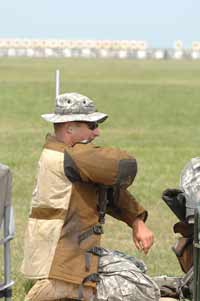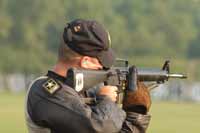

| We want your feedback! Please let us know what you think about TFS. Do you have an interesting story or article that you would like to share? If so, please let us know!
|
Reader Comments:
CMP Shooters' News is one of my favorite email news publications. Information packed, talented authors, timely subjects, and all around well done. What a great service you are providing to the shooting community. Just wanted to say thanks and Merry Christmas.
Newt E.
I enjoy and look forward to TFS and the excellent articles that are published on a regular basis.
Please keep this publication coming and keep the CMP active.
Don M.
One of the members at Snipers Hide pointed out the newsletter and the High Power Tips articles by the USAMU team.
Darn you! I was up until 1:00 AM last night reading all of the articles. Great newsletter and really great USAMU articles.
Thanks,
Michael E.
Great article written on physical conditioning in the latest TFS. I was one of likely many who had asked about the type of conditioning recommended for serious shooters. Sgt. Craig did a great job on describing the routines. Now it’s my turn to put it to work.
Thanks to you, Sgt. Craig and other contributors who share best practices of shooting excellence.
Sincerely,
Keith H.
I use these articles in our high power clinics and have found them very helpful for both new shooters and reinforcement of the basics for the more experienced.
Thanks, Gary M.
Thanks for the great articles on the Carbine, Springfield, Garand matches. All the articles are interesting, but the Carbine, Springfield & Garand are my favorites.
Jim H.
The September-07 on line shooting tips by SSG Tobie Tomlinson, USAMU Service Rifle Team Member, is a great article. I have reproduced 15 copies of it to hand out and discuss to our “newbie” first year air rifle shooters on our high school JROTC Air Rifle Team. Come to think about it believe I’ll hand out a copy to my advance shooters as well. His explanations are simple to understand but rich in detail. Coupled with the sight pictures this article will go a long way towards helping all our JROTC shooters obtain better sight patterns. Keep up the great work. AND…..keep the articles like this coming.
Malcolm V.
CW2 (R), US Army
It seemed good to read the article on Infantry Trophy Match. As a shooter on the Marine Corp Team way back in 1967 I participated in the Match. We were the second team for the Marines but placed second overall. One of our shooters forgot to put the windage on his rifle. I enjoyed shooting the M-1 and M-14 at Camp Perry and always wanted to go back but never seemed to find the time. The top over all shooter at that time was my team mate Lt. Bowen. I remember some of the team members carrying him from the 600 yd line back to the rest of us. It was a great time in my life and will never forget it. Thanks again for the article.
Mike A.
Thanks for the great series of articles from the USAMU – they are very readable, and usable!
Tom, AZ
Great articles. Great to identify those who are participating as well as those who are working behind the scenes to make the whole of the National Matches run so well.
David D.
Boxford, MA
This is a special note just for my friends at the CMP, I want to thank you all for your hard work and attention to details, it's a great program!
"You help our shooting dreams come true!"
Best Regards,
Tony M.
|
|
|
 |

Coats, Gloves, and Mitts
By PFC Evan Hess
|
|
Supporting the position
Sight Alignment and Trigger Control are the two principles of shooting. A properly constructed shooting position supports these principles. In Highpower rifle competitions, we use both artificial support (either a leather or webbed sling) and bone support (letting the weight of the rifle be supported by your bones instead of your muscles) to help us build a solid shooting position.
Some important factors in achieving this solid shooting position are the use of a shooting coat
and a glove or mitt. The choice to use a coat made entirely out of canvas, canvas and leather or solid leather is up to you. The same goes for gloves and mitts, some prefer different combinations than others but most importantly, everything must fit and be comfortable.
The shooting coat
|
 |
Let us start by talking about shooting coats. Although there are different types of shooting coats, they are all designed to steady your position. This steady position will enable you to shoot smaller groups
on the target. Picking out the right coat may seem intimidating at first, especially if you are new to the sport. Take care to follow instructions on sizing and get a coat that fits! If you are new to the sport, or do not get to shoot very often, I would not recommend buying a very expensive coat. However, if you are an experienced shooter who wants to improve on your performance I would suggest spending a little time and money on choosing the right coat for you. Shooting coats may range anywhere from a few dollars for a used basic model, to over several hundred dollars for the expensive leather coats. For beginners I would suggest a basic, cloth-shooting coat. This type of coat features elbow, shoulder, and body pads for added support. Cloth coats are very simple, but compared to nothing but a t-shirt they work wonders. One of the main features of any coat is that it will protect your arm against the binding effect of the sling. For this purpose alone, the cloth coat will suffice. Start your shooting career with a cloth coat and make a goal of getting your Expert card, before you look to purchase a more expensive coat.
Once you have mastered your cloth coat you should move onto something more stable, such as a “hardback” coat. Good “hardback” coats are constructed of a nylon material
such as 1000 Denier Cordura. This material is very heavyweight nylon with a urethane coating, giving it excellent tear-strength. A “hardback” coat is nearly impossible to wear out. They may also include parts made of leather. Some shooters order the arms, only, in leather. Hardback coats can improve your standing scores dramatically. This type of coat, when properly fitted and adjusted, prevents your lower back from bending. An all leather coat can be more comfortable because of the flexibility of the leather. One negative aspect, however, is that they are much hotter than a Cordura coat. Speaking of temperature, be sure
to pick the color of your coat to suit your locale. Black coats are noticeably hotter than the lighter colors. Custom coat makers give you a choice.
Why use a sweatshirt?
It is a good idea to wear something slightly bulky under your coat. Most shooters pick a sweatshirt or buy a shooting sweater. This helps fill the coat out. Consider the following when choosing between a hooded sweatshirt and a regular, collared sweatshirt. The hood creates too much bulk behind your neck when shooting prone. Some shooters make an extra collar cut in front to free up their neck as well. It seems like almost everyone has a "lucky" sweatshirt. Please do not forget to wash it now and then--it might not be so lucky if your scorer can smell you.
Getting the most out your coat
Here are a few tips about wearing your coat. Unzip the inside of the elbow when shooting offhand so your support arm will fold tight. Make sure you have your coat buckled up tight for standing, especially the lower buckles. In the sitting position, zip up the elbow for stiffness and unbuckle everything except the top two buckles. Use the same technique for prone. If your coat uses plastic buckles, get a couple of extras as replacements.
Buckles always seem to break right in the middle of an important match, but
replacement buckles are cheap and handy. If you find yourself without extras, just move one from the middle to the top or the bottom until you can find a replacement.
Gloves and mitts
|
 |
Have you ever wondered how to decide between using a mitt or a full-fingered glove? One solution is to use both. Full-fingered gloves provide wrist support. This is especially useful in the standing position. You may also buy an oversized mitt and fit a glove into the mitt, giving additional support. The more support you can provide to your hand and wrist, the less fatigued you will become. The use of a full-fingered glove is critical if your standing position requires that you have your fingers close to the ejection port. In the prone and sitting positions, a mitt seems to work for most, although a glove may also be used. Regardless of what you decide to use, putting your name on them
with a permanent marker keeps them from being lost or confused with someone else's equipment.
Soon your coat, glove and sling will start to feel as familiar and supportive as a hug from an old friend, and will
facilitate good shooting and better scores. Eventually your equipment will cease to be a distraction, and you will be able to concentrate on the two principles, sight alignment and trigger control.
|
The USAMU Service Rifle Team is also answering your
questions pertaining to Service Rifle Shooting including topics such as
Equipment and Ammunition, Shooting Positions and Shooting Techniques and
Tactics. Go to http://www.odcmp.com/usamu/shooting_tips.htm
to view the latest questions and answers. If you have a question you
would like to ask, email USAMU@odcmp.com. |
NEXT ARTICLE
|
|
|


